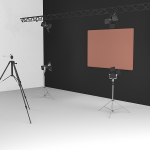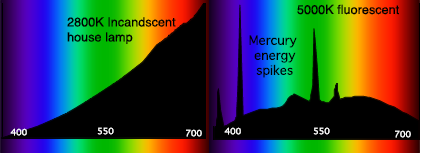
Traditional 4-light copy setup
In this series we are covering the steps to get the optimal reproduction of your artwork, from capturing the digital image to refining, testing and then final printing. In this, Part 2, we will delve into the importance and how-to of proper copy lighting. and exposure.
A Ten Dollar Word
Spectral Power Distribution (SPD) is for our purposes a way to represent how much of each spectrum (color) of visible light is produced by a given light source. This is critical to fine-art reproduction because a lack of a given wavelength means it is not available to be reflected back towards the camera and thus be captured for printing. Too much of a given wavelength leads to an excess of that color that could lead to falsely over-saturated colors in that zone. A lack or insufficiency could result in the color appearing closer to grey, or even black in severe cases.

Spectral Power Distributions of two man-made light sources
In the examples above we see SPD histograms of a common household incandescent lamp and an industry standard 5000k (50D) fluorescent lamp. The former being extremely weighted to the warmer colors and quite deficient in the cooler colors could lead to a reproduction where your cooler hues present nearly grey and your warmer hues present quite saturated when compared to your mid-range colors.
The 5000K fluorescent, while spikey in areas is significantly more balanced, but by no means linear (meaning all spectra would be equal). In this scenario, your blueish and redish values would appear somewhat less saturated when compared to to the mid-ranges.
Another way to look at this is through Color Rendering Index (CRI). This is a 1 to 100 scale that represents how accurately a light source will present colors when compared to a standard. The higher the CRI, the better suited the light source is for both photography of your art and for color corrected viewing of your art. Most household and office lamps such as cool white and incandescents have a low CRI of around 62. The fluorescent bulbs we use to view art and color correct reproductions has a CRI of 92 or higher. Some high end tungsten halogen bulbs can reach into the high 80s.
